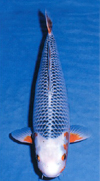Koi Variety Guide

Koi Variety Guide to help you select your fish?
At Andreskoi.com we strive to bring you the best koi varieties available from the top breeders in Japan. The owner Andy Moo makes several trips per year to Japan to hand select the koi for his annual koi growth contest and his year round sales. Andy is please to provide his customers with quality Asagi, Bekko, Doitsu-goi, Goshiki, Hikari-moyomono, Kawarimono, Kinginrin, Kohaku, Koromo, Kumonryu, Ochiba, Ogon, Showa, Shusui, Taisho, Tancho and Utsurimono.
Asagia koi with light blue above and red below. The name means “light blue” in Japanese. |
|
Bekkowhite, red, or yellow, skinned with small black markings sumi. The name means “tortoise shell,”. The white red and yellow varieties are called Shiro Bekko, Aka Bekko and Ki Bekko respectively. Sometimes confused with the Utsuri. |
|
Butterflynot considered Nishikigoi. It has long fins, a version of all others. It was bred in the United States and introduced back into Japan. |
|
Doitsu-goiGerman mirror carp with a single line of large mirror-like scales along the top. |
|
Goshikiblack with red, white, brown, and blue accents. |
|
Hikari-moyomonowith colored markings over a metallic base, or in two metallic colors. |
|
Kawarimonoa competition category (you cannot purchase a “kawarigoi” from a pet shop). This is a “catch-all” term that cannot be placed into one of the other categories. Also known askawarigoi |
|
Kinginrintranslates as “gold and silver scales.” A metallic scaled fish. Often abbreviated to Ginrin. |
|
Kohakuwhite-skinned, having large red marks on the top. The name means “red and white;” The kohaku was the first patterned variety to be established in Japan in the 19th century. |
|
Koromopatches of blue or black edged scales. This koi first arose in the 1950s as a cross between an Asagi and Kohaku. |
|
Kumonryuchanges color with the seasons. Kumonryu is black with curling white markings. The patterns are thought to be suggestive of Japanese ink paintings of dragons. |
|
OchibaJapanese name means “fallen leaves.” It is light blue with yellow patches, reminiscent of autumn leaves on water. |
|
Ogonmost commonly seen colors are gold, platinum, and orange. Cream specimens exist but are very rare. A one color, but with metallic scales or hikarimono. Japanese name means “Gold.” Variety was created by Sawata Aoki in 1946 from wild carp he caught in 1921. |
|
Showa Sanshokuor Showa Sanke, black with red and white markings. The first Showa Sanke was revealed in 1927, during the reign of Emperor Showa. In the United States the name is abbreviated to just Showa. The extent of shiroji on Showa Sanke has improved, to the point where it can be difficult to tell it apart from Taisho Sanke. |
|
Shusuicreated in 1910 by Yoshigoro Akiyama, crossed a Japanese Asagi with a German mirror carp. The name means “Autumn jade” in Japanese. The fish has no scales, excluding a single line of large mirror scales dorsally, going from head to tail. |
|
Taisho Sanshokuor Taisho Sanke, is comparable to the Kohaku, where they differ, this fish has small black markings called sumi. This selection was first revealed in 1914 by Gonzo Hiroi, breeder, during the reign of Emperor Taisho. In the United States it is abbreviated to just “Sanke”. |
|
Tanchowith a solitary red patch on top of its head. May be a Tancho Showa, Tancho Sanke, or even Tancho Goshiki. Named after the Japanese crane which also bares a red spot on its head. |
|
Utsurimonoblack with a white, red, or yellow markings. Renamed Ki Utsuri by Elizaburo Hoshino, a 20th century breeder. Red and white versions are called Hi Utsuri and Shiro Utsuri. The utsuri means to print. |



















